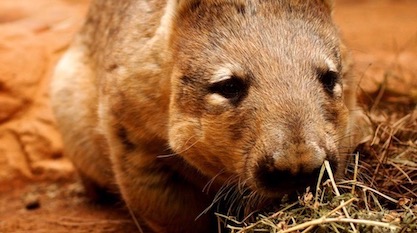 Physics, Earth & Space
Physics, Earth & Space
Was Universe Designed for Hairy-Nosed Wombats?


Professor David Barash of the University of Washington is an evolutionary biologist known for delivering a yearly talk to his students disabusing them of the idea that science can reasonably be reconciled with religious faith. He boasted about this in the New York Times. He calls it The Talk.
Writing today over at Aeon, he offers an essay on “Anthropic arrogance,” arguing that, “Claims that the Universe is designed for humans raise far more troubling questions than they can possibly answer.” He begins by cracking wise.
Welcome to the ‘anthropic principle’, a kind of Goldilocks phenomenon or ‘intelligent design’ for the whole Universe. It’s easy to describe, but difficult to categorise: it might be a scientific question, a philosophical concept, a religious argument — or some combination. The anthropic principle holds that if such phenomena as the gravitational constant, the exact electric charge on the proton, the mass of electrons and neutrons, and a number of other deep characteristics of the Universe differed at all, human life would be impossible. According to its proponents, the Universe is fine-tuned for human life.
This raises more than a few questions. For one, who was the presumed cosmic dial-twiddler? (Obvious answer, for those so inclined: God.) Second, what’s the basis for presuming that the key physical constants in such a Universe have been fine-tuned for us and not to ultimately give rise to the hairy-nosed wombats of Australia, or maybe the bacteria and viruses that outnumber us by many orders of magnitude? In Douglas Adams’s antic novel The Hitchhiker’s Guide to the Galaxy (1979), mice are ‘hyper-intelligent pan-dimensional beings’ who are responsible for the creation of the Earth. What if the Universe isn’t so much anthropic as mouse-thropic, and the appearance and proliferation of Homo sapiens was an unanticipated side effect, a ‘collateral benefit’? [Emphasis added.]
Did I say he cracks “wise”? Wrong word.
A Puerile Challenge
This is well-timed because Ann Gauger’s beautiful essay this morning, “Beyond Adapation: The Human Brain Is Something New,” answers the puerile challenge very nicely. In a universe “designed” for mice or hairy-nosed wombats (which, by the way, are a lot cuter than they sound) it would be mice or wombats writing poetry by Elizabeth Barrett Browning.
The human brain, whether you believe it channels the soul or not, is undoubtedly unique in the world of life.
With our brains we write music, dance the ballet, paint landscapes, play chess, and do theoretical physics. We send men to the moon and then bring them back. We contemplate our origin, what and who we are, and give thanks. Non-human primates [like wombats and mice] don’t do these things. Furthermore, these abilities far exceed what is needed for survival, and at least in the case of theoretical physics and traveling to the moon, are not useful for finding true love. The verdict on chess is still out.
The key point that Gauger makes is that of all the exceptional things that humans can do with our minds, the most exceptional are not explained by adaptation, and so can’t be explained by the evolutionary biology that Dr. Barash teaches.
Yes, “bacteria and viruses…outnumber us by many orders of magnitude,” but I’m not able to see the sense or wisdom in privileging sheer numbers as a mark of cosmic significance over, for example, the utterly exceptional ability — unique in the universe, as far as we know — of a human being to say and mean, “Thank you.”
Photo: A hairy-nosed wombat, by VirtualWolf, via Flickr (cropped).
